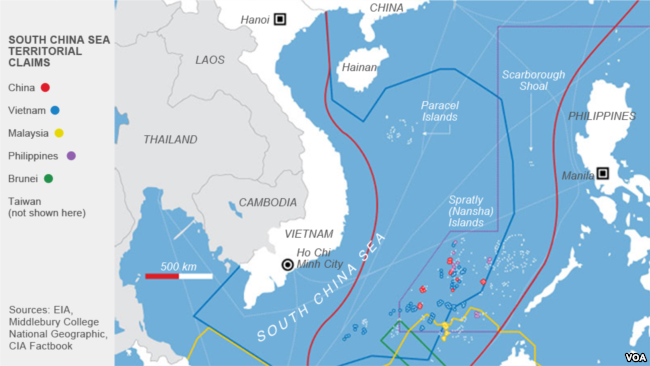
April 19, 2019
Both China and Vietnam are building up tiny islets across Asia’s most disputed sea, but while China receives international criticism Vietnam receives very little, and even gets some support because its pace of construction is slower and widely seen as defensive.
Vietnam’s work on islets it has held for decades is kept to areas of the South China Sea closest to its mainland coasts. The country shuns military mega projects that might appear offensive. And it belongs to the 10-country Association of Southeast Asian Nations (ASEAN) known for working out any bilateral differences. These factors differ from China.
“They’ve never had, I think, a standoff with any other country, because all the other claimants have respectfully kept to their developable spheres around the South China Sea, and I think there’s this intra-ASEAN consensus, that within ASEAN the claimants do not rock the boat so as to present a common front towards China,” said Alan Chong, associate professor at the S. Rajaratnam School of International Studies in Singapore.
Vietnam has slowly added buildings on some of its 10 major islets since 2017, the Asia Maritime Transparency Initiative said in a report earlier this month. The initiative under the U.S. think tank Center for Strategic and International Studies also tracked new communications equipment, a sports field and the extension of a runway from 750 meters to 1,300 meters on its largest holding Spratly Island.
Locking in occupation
Development of military-controlled islands that Vietnam has occupied for decades in the South China Sea’s Spratly Island chain involves landfill work plus installation of solar panels on some buildings, the initiative report says. The report points also to 25 “pillbox” forts that Vietnam has built on sometimes submerged reefs or banks.
Vietnam is very slowly reclaiming land for construction that offers self-defense against harsh weather, said Trung Nguyen, international relations dean at Ho Chi Minh University of Social Sciences and Humanities. Construction has shunned use of large ships that might grab international attention, he said.
“The Vietnamese government has made it very clear they just reclaim the islands for self-defense, and they do not expand massively for other purposes,” Nguyen said. “I don’t think the Vietnamese government wants to draw a lot of attention from other countries on their reclamation, so that’s the reason they want to do it quietly.”
Hanoi hopes its tiny islets can get by without much help from mainland Vietnam, Chong said. He said the country is preparing for a long stay on the islets.
Vietnam is upgrading islets to make them harder for China to take without a cost, not for offensive military use, Asia Maritime Transparency Initiative Director Gregory Poling said.
“The Vietnamese endgame seems to be making these facilities more survivable, raising the cost for the Chinese to try to take them,” he said.
China normally leaves Vietnam alone at sea because they have shown a willingness to “bump shoulders” with Chinese vessels if pushed, he said.
China contrast
China claims about 90 percent of the disputed sea, overlapping Vietnam’s smaller claim as well as tracts that four other governments call their own. The other claimants are Brunei, Malaysia, the Philippines and Taiwan. Chinese reclamation work particularly alarms Vietnam because China controls the full Paracel archipelago, also claimed by Hanoi, and three major islands in the Spratly chain.
Beijing’s reclamation work has created infrastructure for military aircraft and radars, the think tank initiative says. Chinese contractors had used 1,294 hectares of reclaimed land to help develop reefs and atolls under their control, according to a Pentagon estimate in 2016.
China draws attention from other countries, including the United States, when it sends bombers and naval vessels into the sea. Both China and Vietnam cite historic usage to back their maritime claims.
Keeping peace
China and the Philippines have complained occasionally to Vietnam over the years because its islets fall into their claims. But the complaints fade because the other countries do not see Vietnam as a threat, scholars believe.
Vietnam’s armed forces and maritime development budget lag China, which is Asia’s top economic and military power. Chinese officials meet sometimes with ASEAN leaders but lack access to the regular events for Southeast Asian heads of state, defense chiefs and foreign ministers.
“One ASEAN country is not going to war with another ASEAN country,” said Oh Ei Sun, senior fellow with the Singapore Institute of International Affairs. “We would find consensus. That’s the true spirit of diplomacy.”
Vietnam also has picked up support from Japan and the United States, both keen to limit Chinese expansion. Japan’s agreement in 2014 to donate six coast guard vessels to Vietnam helped prove its “power projection abilities,” Chong said. The U.S. Navy regularly passes ships through the sea to warn China.
